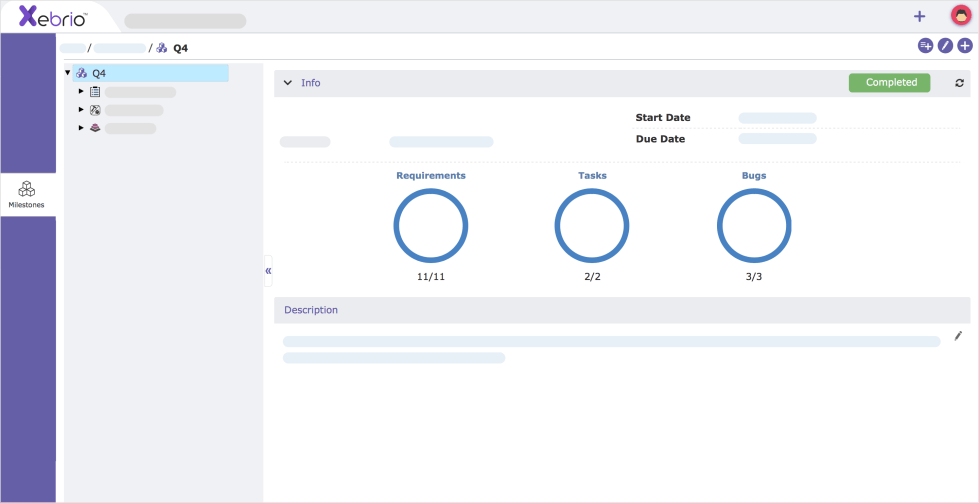What does success mean to you?
Is it a big house? A flashy car? Good health and a loving family? Or something else entirely?
Different people will respond differently, and there is no right or wrong answer. It all comes down to how the individual defines success.
How would you define a successful project? On-time and within budget is an obvious indication. But there are other measures of success, too. Customer and stakeholder satisfaction, for one, and going beyond stated performance goals, for another.
That’s why it is so important to define project success criteria before starting. This provides a clear aim, and a way to measure performance.
What Makes a Project a Success, Anyway?
A key aspect when judging the success of a project is to ask whether it has achieved its primary goal – whether it provides a solution for the problem that it aims to solve.
This is something that should be stated upfront. It should be specific, achievable, and signed off on by all stakeholders. Such goals, for example, can be along the lines of increasing the availability of water supply to an area by 25%.
Then, there are objectives. These are the step-by-step parameters that will help in achieving the goal. With the example above, the objectives can be – to lay a certain number of pipes, to connect a certain number of households, to conduct a certain number of salinity tests, and so on.

Many project managers act ‘SMART.’ This acronym states that objectives ought to be ‘Specific, Measurable, Achievable, Realistic, and Time-bound.’
Another filter is that objectives should answer the five Ws. They should be framed, keeping in mind the ‘Why, What, When, Where, and Who.‘
It is important to get clarity on all of the above before starting a project. Taking time to do this, and clearing it with all involved, will also provide a sense of purpose to a project.
The Flip Side: Why do Projects Fail?
You have defined the project goal, outlined the objectives, and cleared it with all stakeholders and team members. All of you understand the project’s success criteria. Yet, the project doesn’t succeed.
Sad, but true. This happens. The question is, why? And since forewarned is forearmed, let’s look at the five major reasons.
1. Lack of Resources
This is common. Be it financial, or the number of people, or the lack of technology, scarce resources make it very hard to complete a project successfully. This can be a poor senior management decision or an underestimation of requirements needed for the project.
2. Scope Creep
The two dreaded words that you’ve probably often experienced – Scope creep. Once a project is underway, the number of deliverables suddenly starts to expand, requirements shift, reassessments occur, and before you know it, everything has spun out of control. This is scope creep, something that shouldn’t be allowed.
3. Inexperience
Sometimes, a person who is good with the technical aspects of a project is made manager. At other times, a team member who is used to a particular way of work can’t handle a shift in a process. At yet other times, a situation arises for which a manager has no prior knowledge. Such a dearth of experience can cause delays and roadblocks.
4. Unrealistic Deadlines
Tight deadlines, or those which are set without taking all the factors into account, are one of the most cited reasons for project failure. Objectives are rushed through, and chances for error are higher. Lack of experience, or foresight, is often the cause.

5. Poor Communication and Collaboration
Projects are dynamic, evolving entities. Everyone has to be on the same page at all times. When communication among team members is lacking, it results in questionable outcomes and long processes. Such lack of communication can also exist between stakeholders, or come from senior management. Another aspect is the inadequate collaboration between all project members. It’s like a tug of war where everyone is pulling in different directions, and no one knows which is the right way to go.
All of the above can be anticipated to some degree, but there’s another factor that can’t be planned for when it comes to project objectives and success criteria. And that is – sheer unpredictability. Some events are simply out of our control, and they can derail projects significantly. As the Harvard Business Review points out: “Managers expect they can plan for all the variables in a complex project in advance, but they can’t. Nobody is that smart or has that clear a crystal ball.”
The Art and Importance of Measuring Success
With goals and objectives clearly discussed and defined, there’s another question you should ask: How do you exactly measure project success? This takes the guesswork out of the results. It provides a clear compass for judgment and offers templates and learnings for future projects.
Certainly, you can say that a project that is delivered within the deadline and the budget is a success. But that’s not all. Other measurable project objectives, such as client satisfaction, stakeholder fulfillment, and value creation, for instance, also should be in the picture.
Ideally, you should give a thought to all ramifications related to a project before you start work. This will not only put the project and its progress on a sound footing, but it will also make it easy to determine how successful it was.
And at the end of it all, you and your team will have picked up a valuable set of instructions for future projects.
Some Specific Criteria for Project Success
Now for a few nuts and bolts. What are the criteria that should be indicators of project success?
They can vary from project to project, but there are a few broad rules you can use.
Make them specific
They should not be open to interpretation by different parties. Hence, deadlines, budgets, key deliverables, and other measurable entities, ideally based in data, should be spelled out.

Make them aligned
Depending on the project’s goal, the criteria should spell out the results expected, the value gained, and the constraints within which progress is to be realized.
Make them collaborative
There should be a structure by which stakeholders have a say in defining criteria, and then signing off on the output. This will establish that everyone is in the same boat.
After this, you should have a set of criteria that the project can be measured against. Success criteria examples include:
- Was the project completed on time?
- Was it within budget?
- Were quality standards adhered to?
- Were all items in the project scope covered?
- Did the project satisfy revenue and income parameters?
- Were there acceptable satisfaction levels across the project team, suppliers, and end-users?
Measuring Project Success With Key Performance Indicators (KPIs)
A useful way for a project manager to look at performance is to see project success criteria as KPIs. Again, these work best when they are aligned, measurable, attainable, and clear.
Bernard Marr, a well-known business analyst, has come up with a list of the best ways to develop effective KPIs.
Marr also adds a tip – you should identify your data needs and evaluate existing data. Without these, measuring KPIs as indicators of project success, or as trustworthy project success criteria will be an imperfect exercise.
You should make sure that clear responsibilities and deliverables are assigned for specific KPIs. All team members should be aware of their ongoing ownership.
As for the actual KPIs and success criteria examples, they can be broken down into:
Profit
Many metrics can be applied here, based on your company’s calculation of ROI, such as net profit, net profit margin, gross profit margin, operating profit margin, total shareholder return, and economic value-added.

Customers
In this set of project success KPIs, you can look at aspects such as customer retention rate, customer satisfaction index, customer complaints, and customer engagement.
Marketing
These relate to marketing efforts and score – for example, market share, cost per lead, conversion rate, and online share of voice.
Operations
These KPIs deal with operational performance. Here, you can track aspects such as Six Sigma, capacity utilization, inventory shrinkage, and time to market.
Employees
In this case, the KPIs will measure aspects related to people performance. The metrics used will measure revenue per employee, employee satisfaction, churn rate, training ROI, and so on.
Environmental
These KPIs measure both ecological impact and social sustainability. Some of them are the carbon footprint, your waste recycling rate, energy consumption, and water usage.
Of course, the project success KPIs that are chosen depends entirely on the goals and objectives you define and the nature and the size of the project. But, if you keep the above in mind, you’ll come to a greater understanding of all that can be measured for success.
Project Success Criteria Measurement Traps
You ought to guard against some common pitfalls that project managers can fall victim to.
Generally speaking, there are two types of snares.
1. The criteria
If they are conflicting, there will be confusion as you progress, and not clarity. If they are too few, you may forget about other important issues. If there are too many, there is a higher possibility of conflict. Finally, if they are ambiguous and too general, there will be a lack of clarity, especially when it comes to measurement.
2. The Yes/No paradigm
All too often, we grade success in black-and-white. But with projects that have many objectives and stakeholders, it’s better to rank the factors on a spectrum. For example, a scale of one to ten. This will also allow you to improve when it comes to future projects.
When Should You Track Progress?
As a professional, you know that the best way to begin is to identify all requirements, divide these into smaller units, outline tasks needed to complete them, estimate the time needed, and establish the project’s critical path.
All this is to be achieved, of course, with plenty of communication and collaboration, with the stated project objective and success criteria. A key step is to schedule regular reviews to check on progress. It is during these reviews that you can begin to track the project’s success.

When you make a project plan, you must lay down measurable project objectives, along with a timeline, this becomes achievable through metrics. You can track what percentage of a task is complete. You can check on whether key milestones have been reached when they were supposed to. You can see whether any goals have been missed and what you need to do to catch up. And, of course, you can keep an eye on expenditure, in line with the total project budget.
Investing in project management software is the best way to measure and track the progress of your project continuously. Make sure that the project management tool & Bug Tracking Tools that you invest in has a provision to view and analyze reports so that teams can gain insights into the project and devise ways to be more productive and get to the finish line faster.
Not only so, but a project management tool that has milestones helps you group together tasks that form a significant deliverable and monitor it better, with more control over the work and the monitoring of the tasks, test cases, and requirements pertaining to a certain milestone. In fact, there are some new tools that offer milestone tracking with task management, requirements management, and test case management, too.

Measuring Project Success After Completion
Once a project is complete, the task of measuring its success remains to be done. Naturally, during the course of the project itself, you and others involved will have a good idea of this. The project success criteria document that should have been drawn up before starting project work will be your guide here.
The measurement of goals, objectives and other benchmarks is based on data. Thus, such data collection and entry must be regularly done and updated during the course of a project. Well-documented criteria will provide a clear indication of the project’s success. Detailed documentation, preferably indexed to past projects, will be of great help. Measurable project objectives will also be a guide to future projects.
Success is a Moving Target
There is no one factor upon which a project’s objectives and success criteria can be evaluated. Further, there are many dimensions to indicators of project success. It can be seen as a scale on which one moves up or down, depending on the circumstances.
Establishing the right criteria, and then measuring and documenting them, is vital. In this way, step by step, you can confidently move up the scale to establish further yardsticks of your own.






0 Comments